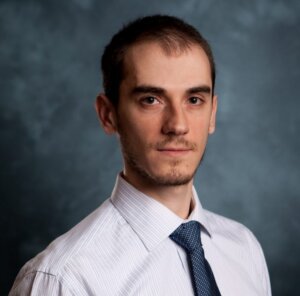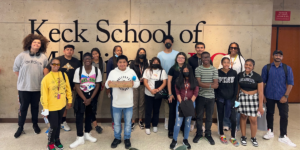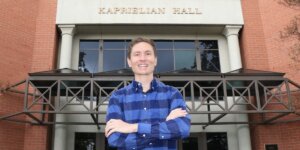For researchers in the USC Sonny Astani Department of Civil & Environmental Engineering (CEE), the city of Los Angeles where we live and work is experienced as a test site for larger global concerns – a space where locally gathered observations can be extrapolated to generate widely applicable solutions.
Disaster resilience, urban livability and transport service systems are the key pillars of the CEE strategic plan. So, when a two-mile segment of the Interstate 10 in downtown Los Angeles – a vital transportation corridor serving more than 300,000 drivers daily– was subject to a major fire in November 2023, the incident immediately raised discussion.
In the following short reflection, Professor Bora Gencturk shares his perspective on the role of building materials – specifically, reinforced concrete – in mitigating the damage caused by fire events. His area of specialism drills down to the principles of structural engineering that underpin urban infrastructure, developing principles that can be applied to extreme events including fire and earthquakes. As director of the USC Structures and Materials Research Laboratory (SMRL), Gencturk leads a team of researchers at the forefront of developing new materials and structures for use in civil, aerospace and energy applications.
As it happens, the fire-damaged section of the freeway was rapidly reopened after a week of repairs – just in time for the Thanksgiving rush. However, the incident does raise awareness of the ever-present risk of an even more consequential event. Research plays a key role in generating the new knowledge that enables proactive defense against disasters – Gencturk’s perspective is just one of the many ways of addressing the problem from the inside out, with the primary goal of securing greater urban resilience for a safer, more sustainable and prosperous world.
Gencturk’s Perspective:

Associate Professor Bora Gencturk
“Reinforced concrete structures maintain high durability against fire events. Concrete is a non-combustible material, protecting the embedded steel reinforcement from the high temperatures of a fire event.
The temperatures and duration of the fire determine the residual capacity of the structure. These factors are influenced by causes such as the source of the fire (the material being burned), the quantity of the burning material and the environmental conditions (indoors or outdoors), among others.
Concrete performs very well up to temperatures of about 300°C. Higher temperatures cause the onset of degradation due to various chemical reactions, including the dehydration of the concrete binder and the build-up of internal pressure from the moisture in the concrete.
In the case of the I-10 fire, the available videos and photographs indicate that the fire was mainly located in the central region under the freeway bridge, mainly affecting about 10 of the bridge columns. Some flaking (spalling) of the concrete cover that protects the reinforcing steel bars is apparent.
This demonstrates internal pressure build-up and damage to the concrete and potentially to the steel. The good news is that the damage seems to be mostly localized to these columns. The degradation in the concrete may not have permeated too deeply into the column cross-section, allowing the columns to continue to perform their role in carrying the vertical loads from the superstructure: the beams, road and all the auxiliary structures (such as the rails).
It has been reported by Governor Gavin Newsom that the damage to the concrete was not as bad as originally believed. This may be attributed to several reasons, including the shallow depth of the degradation due to lower fire temperature and/or the concrete having a higher strength than it was originally designed for – this is very typical for concretes used in bridge construction in the recent years.
In a structure with sufficient redundancy, the failure of one or more members does not result in the failure of the entire system. The bridge superstructure is carried by approximately 100 columns, potentially capable of redistributing the load of the more heavily damaged columns to those that are still in good condition. Furthermore, the damage to the beams under the roadway also appears to be relatively minor. With some repairs to the heavily damaged sections of the bridge, mainly focused on restoring the axial and lateral load carrying capacity of the columns, it is anticipated that the bridge can be brought back to pre-fire conditions.
Click here to learn more about the CEE researchers tackling disaster resilience, urban livability and transport service systems.
Published on December 5th, 2023
Last updated on December 11th, 2023












